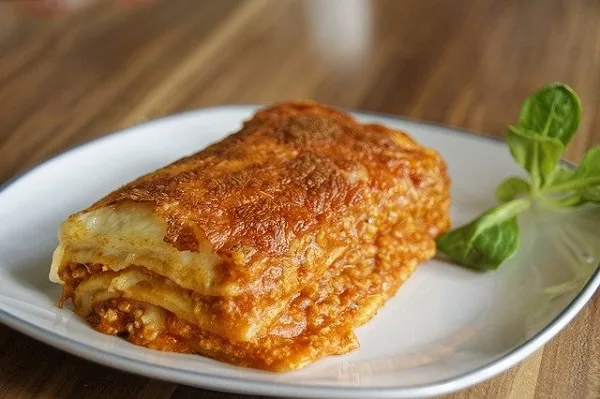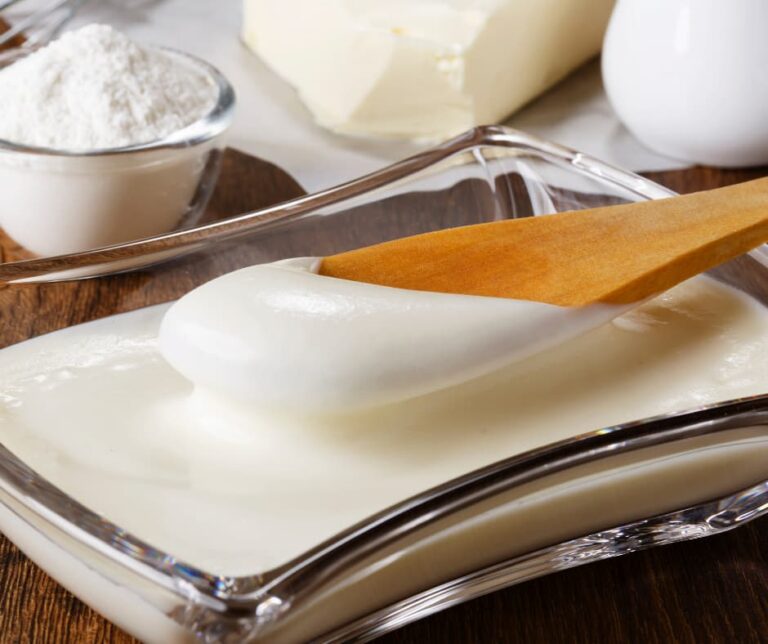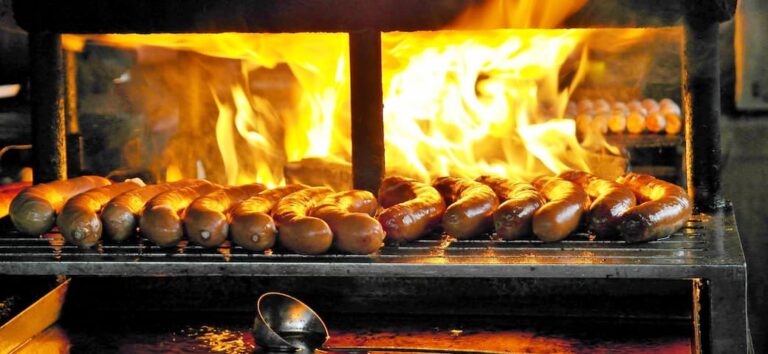If I had to think of flavors that remind me of my childhood, one of them would definitely be bechamel sauce (or, more precisely, béchamel sauce).
There was a time when my aunt used it at almost every Sunday lunch. Vincisgrassi, crespelle, lasagna… all of these meals were enhanced by its sweet cheesy flavor. We kids loved it so much that we would eat it by the spoonful as soon as we found an unattended bowl.
Also known as white sauce, bechamel can make the difference between success and a total failure in every recipe that features it – especially if you’re a dairy enthusiast. It’s not difficult to make, and yet I’ve never found a good one on store shelves.
So, a while ago I shared an easy béchamel sauce recipe, and today I’m adding to it a full guide on this wonderful dairy product. What it is, who invented it, how does it taste like… and of course, the best recipes with bechamel sauce. Let’s get started.
Table of Contents
Bechamel sauce: what is it?
Bechamel is a creamy white sauce made with milk and white roux (a mix made of butter and all purpose flour). It’s very easy to make, and doesn’t require much time or money. In my area, buying it at the store usually costs more than making it at home.
It’s also one of the 5 so-called “mother sauces“, which are one of the building blocks of classic French cuisine. These sauces are béchamel, velouté, espagnole, hollandaise, and tomato sauce. What makes them so special is that they can be used to make all the other existing sauces. They are all made with roux mixed with different gravies or animal products (in this case: hot milk) and have endless possible applications.
This, however, is a subject for another article, so let’s just see what else makes béchamel so special.

What does bechamel taste like?
The roux acts as a thickening agent. Therefore, béchamel sauce usually has a thick and smooth consistency.
The salt and the occasional presence of nutmeg and black pepper can make it a little spicy. When mixed with tomato preserve, it becomes the perfect dressing for any kind of pasta.

Is it the same as Alfredo sauce?
Not really, although it looks like it. Unlike bechamel, Alfredo sauce is generally made with heavy cream and other ingredients like grated parmesan cheese, pasta cooking water, garlic, and so on.
Who invented bechamel sauce?
There are four main theories about who invented béchamel sauce. Three of them assert that this basic white sauce originated in France, while another one suggests that it may derive from an Italian ancient sauce.
For a long time, bechamel was considered to have French origins. After all, it has a French name and is very common in French cuisine. According to some, its name may derive from that of marquis Louis de Bechamel, who started to propose it in his recipes in the 17th century.
Nowadays, however, many chefs agree that bechamel probably originated much earlier in Tuscany and was imported to France by Caterina de Medici in 1533. Some even think that its name may come from some beauty masks made with flour and water, which were used by women in Florence.
Whatever the true story is, béchamel sauce is very common in both French and Italian culinary traditions. This leads us to another very important question – the most important one indeed: how do I use it in the kitchen?
Recipes using bechamel sauce
What is bechamel sauce used for?
It’s very common to find this creamy sauce in French dishes like croque madame or croque monsieur, or as a basis for other French sauces like Mornay sauce (for which you just need to add some gruyere cheese). It can also be used for Moussaka (a Greek casserole) and for other dishes like: mac and cheese, fish pie, cream Spinach, etc. Generally speaking, you can use it in any recipe with a cheese sauce.
And what about Italian cuisine?
Well, it is a very important ingredient in many famous Italian foods. Here are my favorite recipes.
Appetizers
Bechamel sauce can be a perfect dipping sauce for many appetizers.
Generally speaking, any types of meat bites will do. I’m thinking buffalo chicken wings, mini meatballs and Velveeta sausage dips. It will also go very well with potato bites and mozzarella sticks.

Pasta courses
If you know me, you know that baked pasta is my favorite comfort food. EVER.
And guess what: béchamel sauce goes particularly well with them.
So, it should not come as a surprise that most of my favorite pasta recipes using bechamel sauce are cooked in a baking dish. But don’t worry: if you are not an oven person, you can also use it as a simple pasta sauce. Here are some things you might try.
Lasagna
It may come as a surprise, but in many parts of Italy, classic lasagna is actually made using bechamel sauce instead of ricotta and other cheeses. This makes it a little creamier and gives it a nuttier flavor.
You can try this method with any lasagna recipe. Just pick your favorite one, mix the bechamel with the tomato sauce, and spread it evenly over each layer of lasagna noodles.
Don’t know where to start? Try it on a vegetable lasagna: bechamel blends perfectly with veggies! Alternatively, you could make some vincisgrassi, which are similar to lasagna, but made with chicken ragout and more pasta layers.
Timballo di pasta
Similar to the more international macaroni pie, timballo is a dish made by baking rice or pasta with meat sauces and dairies.
There are many regional variations. If you want to try a simple one, here’s my advice.
Take a tubular pasta shape (like ziti, rigatoni, or penne pasta), and cook it on medium heat until it is al dente. In the meantime, take a casserole dish and drop some olive oil on its bottom. When the pasta is ready, toss it in the casserole with some bechamel and bolognese sauce. MIx well, then
It’s an easy and delicious recipe. And if you don’t have time to make the bolognese sauce from scratch, we can ship some to your house!

Cannelloni al forno
A few days ago, I shared a recipe for cannelloni al forno.
It was made with a ricotta filling and meat sauce, but if you want to take it to the next level, do like I showed you for lasagna. Mix the meat sauce with some bechamel, then spread everything over the pasta layer and top with some grated parmesan.
Tagliatelle with Mushrooms and Italian Sausage
Start by bringing some salted water to boil in a pot.
In the meantime, take a couple of Italian sausages, shred them to pieces, and stir fry them over low heat in a saucepan with some olive oil and a couple of grated garlic cloves. When they start to brown, add half a glass of white wine and let it evaporate. Then, add your some round-cut Champignons or porcini mushrooms, and keep cooking for about ten minutes.
When the water boils, add the tagliatelle and cook them for the amount of time written on their box. After that, drain them and toss them in the saucepan with the mushrooms and sausage. Add the bechamel sauce, and mix everything well.

Side dishes
Any vegetable that could go into a parmigiana is a natural friend of bechamel sauce.
So, you can try it instead of provolone cheese on our eggplant parmigiana recipe. You can also use it with our marinara sauce to bake some zucchini.
Also, many recipes for gratinated vegetables call for bechamel sauce. Try it with Brussels sprouts, fennels and leeks.
What to do with leftover bechamel sauce?
To be fair, I don’t know much about what to do with leftover bechamel, because I rarely find myself having to store it 😀
When I make too much of it, I put the rest on a little bowl so that my guests can use it as a dipping sauce for appetizers, or add some more to their plates. However, you can put it in a small container, seal the top with plastic film, and keep it in the fridge for 2 – 3 days.
I know that some people also recommend freezing in an airtight container. This way, you can store it for up to 2 months. However, I never needed to store it for so much time, and I recommend to always eat it fresh. I know I say this a lot but… after all, it’s such a simple recipe!
Now you know pretty much anything worth saying about bechamel sauce. As you can see, you can use it on many kinds of recipes. Which will be the next one you’ll make? Let me know in the comments!









